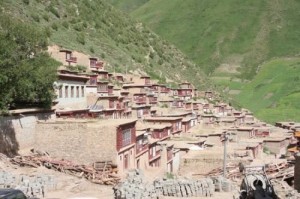
Tongkor (Chinese: Donggu) monastery 60 kilometers from Kardze (Chinese: Ganzi) town in western Sichuan (the Tibetan area of Kham). (ICT)
There is still a heavy troop presence in Kardze town, Kardze Tibetan Autonomous Prefecture, a month on from the suppression of peaceful protests there on March 18. The protests began with a Tibetan man, Sangpo, shouting slogans, who was joined by a crowd of around 100 people. An eyewitness said: “Extra security forces had arrived in Kardze in previous days to bolster security, and they confronted the protestors. They threatened to shoot unless the protestors dispersed, and after that one section of the crowd broke away and obeyed the order. The protestors remained entirely peaceful, not even a stone was thrown. Police moved in on the remainder, beating them with clubs, and arrested at least 12 of them. They beat people savagely, aiming at the head, and it is possible that one or two may have been killed or mortally wounded on the spot, but no-one knows exactly.”
Following the incident, and in the past few weeks, soldiers have been posted at different intersections of Kardze town and at nearby monasteries, restricting the movement of local people and confining monks to the monasteries. Local officials told people in the town that a new political education campaign was being launched to denounce the Dalai Lama and ‘splittist forces’, and that anyone with children attending schools run by the exile government in India or Nepal would have to bring them home. According to one Tibetan source, three monks from one local monastery, Dugu Gonpa, committed suicide, in an act that may have been in protest against the crackdown and subsequent pressure to denounce the Dalai Lama.
The Tibetan service of Radio Free Asia reported that four people were killed during suppression of the protest in Kardze town, including Ngo-ga and 50-year old monk Jamyang Jampel. Also according to RFA, the arrested included Tseten Phuntsok (former chantmaster of Kandze monastery), Chime Gonpo, Pema Dechen, Gonpo, Shao Mimi (a woman aged about 40, wounded in the protest), Tashi Pelden, Loyang, Tsering Dorje and Sangpo.
On April 12, the authorities gathered together senior religious figures and others from all 18 counties in Kardze for meetings, where everyone present was instructed to sign a document opposing the Dalai Lama. The authorities issued the order that from April 13 onwards, a new campaign of ‘patriotic education’ directed against the ‘Dalai clique’ would be instituted in the first group of 43 monasteries in the prefecture.
Kardze county has been the site of more political imprisonment of Tibetans than any other county outside the Tibet Autonomous Region since 1987, according to the Congressional-Executive Commission on China Political Prisoner Database. The People’s Armed Police have used lethal force in three adjoining Kardze Tibetan Autonomous counties in a period of less than three weeks, according to the CECC (www.cecc.gov).
Food shortage threatened due to security sweep in Kham and the situation at Tongkor
In some areas of rural Kham, there are fears for the year’s harvest as protests and crackdown have coincided with the critical sowing season. A source from the Tongkor area of Kham, said last week: “The sowing season has just started but today the agricultural fields are completely deserted and empty. You see only Chinese army roaming around and searching the houses. Except the very old and very young ones, all the monks and all able lay people (farmers) from the surrounding villages have left their homes and gone to places high up in the mountains and forest areas.” The same source said that if sowing could not be carried out in time, there is a severe risk that the local community will not have enough to eat.
On April 3, troops fired upon protestors from Tongkor (Chinese: Donggu) monastery 60 kilometers from Kardze (Chinese: Ganzi) town, killing at least ten to 15 people. (ICT report, Eight Tibetans killed in Kardze: new phase in protests in Tibet) The protests appeared to have been sparked by the arrival of an official work team to carry out patriotic education in the monastery. After the shooting, about 20 seriously injured people were taken to a local hospital under armed guard. This hospital is currently surrounded by troops and according to a report received a few days ago, no visitors are permitted. The local authorities announced a reward of thousands of yuan to anyone who gives information about those who are leaking out the news of the protests and their suppression to the outside world.
The Tibetans who died have been named as follows: Lobsang Rinchen, 20, male; Thupten Zamden, 27, male; Phurbhu Delek, 30, male;Tsering Kyi, 23, female; Telo, 32, female; Sangmo, 34, female; Druklang Tso, 34, female; Tsering Yangzom, late twenties, female; Tsering Lhamo, mid twenties, female; and an unidentified boy in his teens.
Many monks fled from the monastery and were too frightened to return, according to reports received by ICT. According to two reports received from the region, the authorities issued a warning that they would destroy Tongkor monastery if the monks did not return. The monastery is still surrounded by armed troops and locals are deeply concerned about its preservation. Tongkor monastery contains ancient thangkas and other precious religious artefacts that the monastic and lay community managed to preserve throughout the Cultural Revolution. A Tibetan source with close connections in the area told ICT: “Tongkor Monastery is a famous monastery with a long history. Gold statues of Buddha, Thangkha [Tibetan religious] paintings and other valuables survived the disaster in the ‘Cultural Revolution’, but we worry very much whether they can survive this disaster now.”

